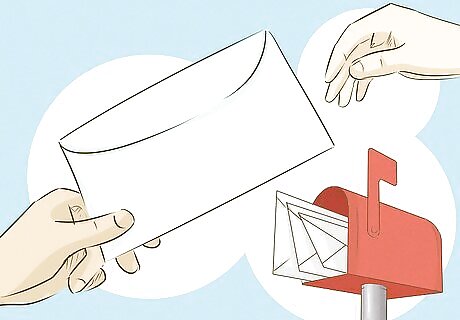
views
Drafting Your Motion

Confer with the other side. In federal court, Rule 37 requires that you make a “good faith” effort to get the information from the other side before asking for the court’s help. Many states also require that you try to get the information from the other side informally. Accordingly, you should reach out before filing your motion. Ideally, you should send a letter. Explain what information the party has not provided you and give them a reasonable amount of time to provide you with the information. Two weeks should be sufficient unless your discovery requests were unusually complicated, in which case you can give more time. Send the letter certified mail, return receipt requested. Hold onto a copy of the letter and the receipt. If the party doesn’t respond, then you should go ahead and draft your motion to compel.

Get your court’s local rules. Most courts have local rules. These rules usually describe the format of your motion, such as its length, content, etc. You can get the rules by looking on the court’s website or by contacting the judge’s chambers and asking for a copy of the rules. Always follow the local rules. If anything in the local rules contradicts what appears in this article, then follow your local rules.

Read your relevant rule of civil procedure. Your state’s Rules of Civil Procedure should give you the right to bring a motion to compel. If you are in federal court, then Rule 37 of the Federal Rules of Civil Procedure gives you the right. Find your relevant rule of civil procedure and read it. Some state rules are very detailed, and they will contain a list of information that you need to include in your motion to compel. Read the relevant rule closely and make sure to include all required information.

Format your document. You should set up the motion so that it looks like other motions filed in your case. Generally, you should set the font to 14 point Times New Roman or Arial. In some courts, you will need to use “pleading paper,” which is paper numbered down the left-hand side. Set the spacing to double spaced. Some courts have blank “motion” forms you can use to file a motion. You should check your court’s website.

Insert the caption. At the beginning of the motion you should insert the caption, which includes the name of the court, the names of the parties, the case number, and the judge’s name. You can get the caption information by looking at any pleading or motion filed in your case. You should also title the motion. You can call it “Defendant’s [or Plaintiff’s] Motion to Compel Discovery” or something similar. Insert the title of your motion just below the caption or below the judge’s name.

Add an introduction. In your introduction, you should briefly request that the court compel discovery. Include any other additional information as required by your rule of procedure. Sample language could read: “The Defendant moves this Court to order Plaintiff to answer the Defendant’s Discovery completely. In support of this motion, the Defendant states….”

Make your argument. In your argument, you should lay out the facts of the dispute. You should also mention the rule that gives you the right to seek a motion to compel. For example, you could include the following information: The date you mailed the other side your discovery request: “Defendant mailed the Plaintiff by certified mail, return receipt requested, a set of Interrogatories on January 22, 2016. See Exhibit A.” The fact that the other side failed to respond to your discovery request: “Plaintiff has failed to respond to these Interrogatories.” The fact that you have attached a copy of the discovery request to this motion to compel. State the exhibit: “Exhibit A contains the Interrogatories Plaintiff wants Defendant to answer.” The date you mailed a letter to confer about the missing discovery. Also mention that you have attached a copy of the letter as an exhibit. “On February 22, 2016, Plaintiff send Defendant a letter by certified mail, return receipt requested. This letter requested that Defendant answer the Interrogatories within two weeks’ time. See Exhibit B. Defendant, however, has not responded to this request.” Request again that the other side respond to your discovery: “The items listed in Exhibit A are requested again by this motion.”

Add a conclusion. In your conclusion, repeat your request that the court issue an order to compel discovery. For example, you could write: “Defendant moves this Court to order Plaintiff to fully answer Defendant’s form Interrogatories within two weeks of this motion date.”

Insert a signature block. At the end of the motion, add the date and then a signature line for you to sign. Underneath the signature line, include your name, and identify yourself as the defendant or plaintiff.

Include a certificate of service. You should tell the court that you provided notice of the motion to the other side. You also should state the date and the method used for providing notice. A sample certificate of service could read: “I hereby certify that a true copy of the above document was served upon the attorney of record for the Plaintiff by regular first class mail, postage pre-paid, at this address: [insert address].” Then include your signature and the date. In some courts, you might not include a certificate of service. Instead, you will have the person who made service fill out a Proof of Service form, which you can get from the court clerk. Read your local rules and your relevant rules of civil procedure to see which method is required.

Draft a proposed order. In many federal courts, the judge will want you to submit a proposed order along with your motion. Read your local rules to check. You should draft the order on a separate piece of paper and title it “Order Granting Defendant’s Motion to Compel Discovery” or something similar. Include the caption information at the top of the page. The language of the order could read: “Having considered Defendant’s Motion and finding good cause therefore, IT IS HEREBY ORDERED that Defendant’s Motion to Compel Discovery is GRANTED.” Then include a line for the judge’s signature and a line for the date.

Create exhibits. You might need to attach exhibits. Attach anything you refer to in the body of your motion. For example, if the other side hasn’t answered your “interrogatories,” then you can include a copy of them as an exhibit. You also will probably include a copy of your meet and confer letter. Be sure to attach an exhibit sticker to any exhibit. Also give the exhibit a name, such as “Exhibit A.”
Filing the Motion

Determine your hearing date. As the party filing the motion, you will need to set a date for the judge to hold a hearing on your motion. Your state or court will require that you schedule the hearing a certain number of days after the date you filed the motion. Read the rules of civil procedure and the local rules. For example, in California, you must file the motion 16 days before the hearing date. You do not count weekends or holidays. Accordingly, if you want the hearing to be held on June 18, then you must file the motion by May 24th. Each court will handle scheduling hearings differently. In some courts, you will have to fill out a Notice of Hearing form. In other courts, the clerk will be responsible for notifying all parties of the hearing date. Ask the court clerk about the method used in your court.

Send a copy of the motion to the other side. Any time you file a motion, you must give the other side notice. You can typically serve notice by sending a copy of the motion and any notice of hearing to the other side’s lawyer. Generally, notice can be hand-delivered by anyone 18 or older not a party to the case, or it can be mailed. Pay attention to your court’s deadlines for serving notice. If you have someone hand-deliver the notice, then you can usually deliver notice on the same day that you file. However, if you serve notice by mail, then your court’s rules might require that you tack on additional days. In California, for example, you can hand-deliver notice on the same day you file the motion. However, if you decide to mail the notice, then you must add five additional days. Accordingly, you might have to serve notice before the deadline for filing with the court.

File your motion to compel. In some courts, such as federal court, you may file all documents electronically. Notice will be sent to the other side electronically. However, you might file motions in person by submitting the paper original. Generally, you will file the motion in the same manner that you filed your complaint or answer. Depending on the court, you may have to pay a filing fee. The amount will differ by court.
Getting Legal Assistance

Meet with a lawyer if you have questions. You might be unsure whether or not you should file the motion to compel. Or you might have questions about what should be in your motion. In these situations, you should meet with an attorney to get expert advice tailored to your circumstances. You can find a lawyer by contacting your local or state bar association. Bar associations are professional organizations made up of attorneys. Many of them run referral services or can direct you to a private referral service. Once you have the name of a lawyer, you should call and ask to schedule a meeting. Tell them why you need help and ask what their fee will be.

Get free legal aid assistance. There are probably free legal aid organizations nearby, which you could also contact if you don’t have the money to pay a lawyer. Legal aid provides free legal services to people in financial need. Visit the Legal Services Corporation’s website and click on “Find legal aid” link. You should also stop into your courthouse, which might have a self-help center or volunteer attorneys who can advise you. However, the court clerk cannot give you legal advice.

Show the lawyer your draft motion to compel. You can get the lawyer’s input about what you have written. Also talk about what will happen at the hearing. You want to make a crisp, coherent presentation to the judge.




















Comments
0 comment